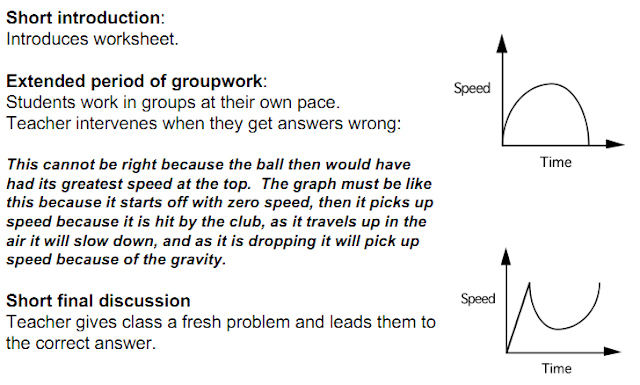Here's how it happened: "cumulative graph" lead to this site, which introduced me not only to what seems to be an outstanding researcher and communicator, Malcolm Swan, but also to a whole set of awesome activities for teaching statistics, algebra, and other things.
Malcolm Swan thus really caught my interest, and google led me to his summary of effective teaching strategies which is extremely user friendly for teachers. What really made me cringe and laugh and decide to shake things up was this collection of powerpoint slides, and especially his comparison of "guided discovery" (what I do a lot of) and "conflict and discussion" (which I mostly do by accident).
To compare the two methods, Swan shows us a problem from from Brekke, 1986, but I think the correct reference is: "Bell, A., Brekke, G., & Swan, M. (1987). Misconceptions, conflict and discussion in the teaching of graphical interpretation." (If someone can find the full article/book excerpt I'd be most grateful, because it's not available through my university library database.)
The Guided Discovery approach:
Ouch. I do that. I thought this was the way to do it, you know, guided discovery is the shit, right?
But when someone puts it like this, I don't want to do it no more.
By contrast, the Conflict and Discussion approach involves
- Individual work
- Discussion in small group (opportunity for conflict when group members have different suggestions)
- Writing about what happens in the problem
- Drawing a graph
- Interpreting the graph back into words (opportunity for conflict when words don't match the writing in step 3)
- Discussing the solution with the whole class (opportunity for conflict when classmates have other suggestions)
- Final (long) discussion about what common errors people make, and why.
Each time there is conflict, students restart from step 1.
Results-wise, Swan cites two studies that find that student concept attainment (as measured by pre- and post-tests) is greatly increased in the Conflict and Discussion method. Astoundingly, students retain their understanding even months after the lesson. I think that's what convinced me that give this a serious try.
OK, so how? Well, conflict seems to me to come from several sources:
- Students self-check and find that their solution doesn't work or make sense
- Comparison with other students reveal conflicting solutions
- Students are shown examples of something that they have a hard time fitting into prior concept.
Building these conflicts seems to require the teacher to above all lay off giving the answer, and instead focus on challenging the students with prompts such as "check if it makes sense" and "compare with that guy" or "well how does .... fit with what you're saying?". Actually, I think another way to create conflict is telling the student that his solution makes no sense or is incorrect (even if it's perfectly correct and makes perfect sense) and then just walking away. I'm not sure that will breed a healthy type of frustration in all students, though.
My main problem, as usual, is that discussions take time, and time I don't have. Swan argues that according to research results, it's more effective to focus on just a few problems in depth than many similar-but-slightly-different questions superficially. I'm going to try this, so let's hope he's right.



Malcolm Swan is a beast. Language of Functions and Graphs is something you need to check out. Let me know if you have a hard time tracking down a copy.
ReplyDeleteDan, thank you for the tip: I just found the PRIMAS project (http://www.primas-project.eu/en/index.do), which I had no idea existed, and from there Language of Functions and Graphs in it's entirety, as well as the Masters for Photocopying with lots of great activities I'll no doubt use plenty.
ReplyDeleteAlso found "Problems with Patterns and Numbers" at http://www.nationalstemcentre.org.uk/elibrary/resource/349/problems-with-patterns-and-numbers which seems to have good materials for a 14-16 year-olds.
Let us know how it goes.
ReplyDeleteGreat post! I have been thinking about similar things lately, but your post here reminded me that how we structure the interchange between individual, pairs, groups, and whole-class is important for allowing students opportunities to share their understanding, listen to the understanding of others, and (potentially) place them in a state of cognitive conflict that is at the center of learning. Thanks!
ReplyDeleteProb something trivial but shouldn't the graph end with a sudden straight line when it hits the ground. Or you just ignoring that?
ReplyDeleteAnonymous, I think that's the kind of question students would benefit from discussing. Ultimately, it will depend on the domain they choose for time.
ReplyDelete